|
Ross Owen
Deputy Director
612-543-1324
Julie Bluhm
Clinical Program Manager
612-348-8400
Lori Imsdahl
Operations Coordinator
612-543-0055
 Like us
on Facebook
Hennepin Health, an innovative healthcare delivery program, is a collaboration between Hennepin County Medical Center (HCMC), NorthPoint Health and Wellness Center
(NorthPoint), Metropolitan Health Plan (MHP), and Human Services and Public
Health Department (HSPHD) of Hennepin County
For more information about Hennepin Health visit www.hennepin.us/ healthcare
|
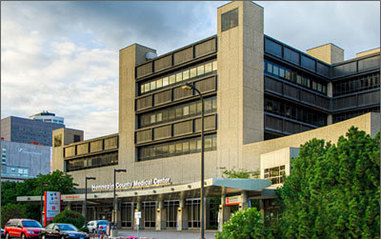 Hennepin County Medical Center
(HCMC) is one of Hennepin Health’s four partners. In addition to its location
in downtown Minneapolis, HCMC has several neighborhood clinics. They include
primary care clinics in Brooklyn Center, Brooklyn Park, Richfield, Saint
Anthony, Golden Valley, and in Minneapolis’ Whittier neighborhood and on East
Lake Street. There is also an HCMC retail clinic in the Walmart store in
Bloomington.
Hennepin
County Medical Center is a:
- Level
1 adult trauma center and level 1 pediatric trauma center
- System
of primary care and retail clinics
- Teaching
hospital
- Safety
net hospital for low-income, the uninsured, and vulnerable populations
- Major
employer in Hennepin County
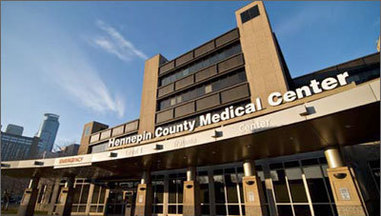 HCMC’s
mission:
“We
partner with our community, our patients and their families to ensure access to
outstanding care for everyone, while improving health and wellness through
teaching, patient and community education, and research.”
Jon Pryor, M.D., M.B.A., HCMC chief executive officer
Jon Pryor, M.D., M.B.A, was named HCMC’s CEO on April 1,
2013. Read on for some notes from a Hennepin Health interview with Dr. Pryor.
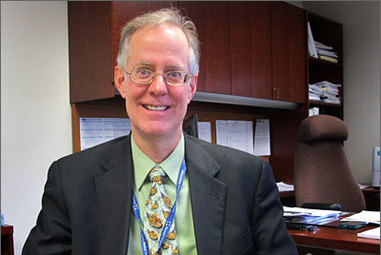 What people involved
in Hennepin Health should know about HCMC
Dr. Pryor believes that HCMC’s mission statement (above) can
tell a person a lot about the organization, especially:
-
Community.
The word is used twice in the mission statement. HCMC strives to partner with
people and organizations within the community and to extend its work beyond the
hospital and clinics.
-
Treat
patients where they live and work. Clinics are distributed throughout
Hennepin County. Convenience is paramount. HCMC offers walk-in options and is
exploring ways to bring health care into the workplace. Eight of HCMC’s clinics
are certified health
care homes.
Reforms that HCMC has
rolled out
Dr. Pryor believes that one of HCMC’s unique features is its
history of innovation and reform. Some examples of innovative, reform-minded
ideas that HCMC has implemented include:
-
Coordinated Care Center. The CCC is a primary care clinic that
caters to complex patients with a history of frequent hospitalizations. CCC
services include walk-in access for new issues, medical follow-up after
hospitalization, oversight by clinic pharmacists, and attention to a patient’s
behavioral health and social needs. In 2013, the
CCC won a National Association of Public Hospitals (NAPH) Gage Award for
population health improvement.
-
Community paramedics.
HCMC uses community
paramedics. Community paramedicine is a health care outreach effort designed to
reach underserved populations. Community paramedics provide primary,
pre-hospital, and post-hospital care. This approach can minimize costs to
providers and patients. Read this article
about HCMC community paramedic David Johnson, C.P., CCEMT-P.
-
Center for Healthcare Innovation. Directed by Pamela Clifford, R.N., M.P.H., the Center
for Healthcare Innovation is engaged in initiatives to improve health care
strategy, innovation, and process improvement. Clifford has been actively
involved in Hennepin Health’s implementation.
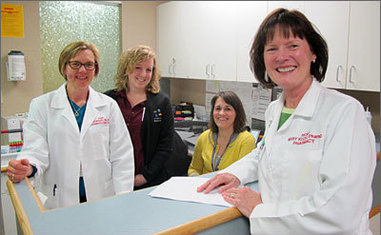 Staff at the Coordinated Care Center. From left to right: Deborah Nugent, Sarah Bruemmer, Susan Gjersvik, and Mary Kuzel.
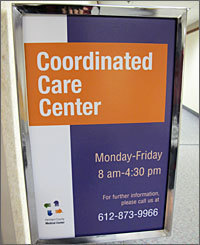 Thoughts about
Hennepin Health
Dr. Pryor believes that Hennepin Health’s four partners
create a synergy, accomplishing more as a group than they could as individual
entities.
Dr. Pryor explains that he’s always looking for
opportunities to deliver health care in new, more effective ways. He has a
background in medical research, and he admires that Hennepin Health is
continuously monitoring and evaluating itself on key outcomes like health care
utilization. He believes that Hennepin Health’s focus on continuous improvement
has led to “good care today and better care tomorrow.”
Revelations made
during a career in health care
One revelation that Dr. Pryor says he’s had about health
care during his career is that health care is not physician centric. Rather,
it’s a team approach. He believes that it “takes a village” to improve the
health of an individual or community. He’s also realized that health care
delivery must extend beyond the hospital and clinic and out into the community.
Meeting an individual’s social needs (e.g., food and housing) can greatly improve
their overall health.
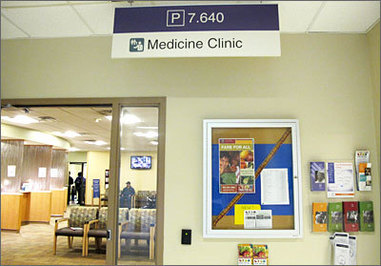 Medicine
Clinic is located at HCMC’s downtown facility, on level 7 of the Purple
Building.
Staff at this primary care clinic take an integrative
approach to health care; a patient’s medical, behavioral health, and social
needs are all considered.
The Hennepin Health
connection:
Several staff at Medicine Clinic helped launch Hennepin
Health in January 2012 and remain involved in the program. Here are two:
-
Mark Linzer, M.D., director of the division of
general internal medicine. Linzer co-leads Hennepin Health’s care model committee.
Dr. Linzer also sponsors one of Hennepin Health’s reinvestment
initiatives, a population health management program based on team huddles.
- DeAnn Rice, R.N., P.H.N., practice manager for
Medicine Clinic. A member of Hennepin Health’s care model committee, Rice gave
input into the makeup of Hennepin Health’s care coordination team. She also
championed Epic dashboards that help providers see a list of patients who are
currently hospitalized, recently discharged from the emergency department, and due
to come in for an appointment within five days. Rice believes that the Hennepin
Health model has been beneficial to HCMC as a whole; it’s helped the medical
facility integrate care coordination into all of its facilities.
 Staff at Medicine Clinic. From left to right: Mary Ellen Chinander, Mark Linzer, Eugene Galybrek, Susan Burns, and Patricia Brown.
Medicine Clinic protocol is shaped by Hennepin Health. Here
are some examples:
- Before staff at Medicine Clinic start accepting
patients each morning, they generate a list of Hennepin Health members who have
an appointment that day. Then, they huddle for 30-minutes to discuss these
patients.
- Medicine Clinic staff help Hennepin Health patients
fill out a lifestyle overview. The survey asks questions that help care
coordinators identify a patient’s medical, behavioral health, and social needs.
Care coordinators and Hennepin Health patients use the findings when they are crafting
a patient’s care plan.
Insights from
Medicine Clinic’s care coordination team:
Mary Ellen Chinander, R.N., clinical care coordinator, tries
to incorporate “teachable moments” into every encounter she has with a patient.
Teachable moments, she explains, are opportunities to talk to a patient about
behaviors that aren’t serving them well, and to empower a patient to take
personal responsibility for their health.
She recalls a teachable moment she had with a Hennepin
Health member. The member had a history of frequent hospitalizations for mental
health concerns and alcohol abuse. He was trying to regain control of his
health so that he could hold a job. One day, the member told Chinander that he
was determined to keep all of his outpatient appointments because he realized
that the more outpatient appointments he kept, the less he would need to be
hospitalized or use the emergency department. Chinander was quick to
congratulate the member for making this connection.
Eugene Galybrek, R.N., clinical care coordinator, says that
his work at Medicine Clinic boils down to building relationships and building
trust. He’s worked with many patients who were initially resistant to making the
lifestyle changes that their providers suggested. However, as their
relationship and trust in Galybrek grew, they were more inclined to
follow-through and take personal initiative.
To make an appointment at HCMC’s Medicine Clinic, call (612)
873-6963.
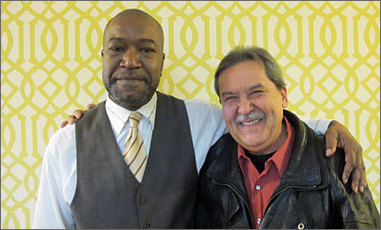 Jorge (right) with a friend.
Jorge emigrated from Mexico to Minnesota in 1999. At a
recent meeting with Hennepin Health staff, he explained that he used to have a wife, a brother, and a son.
And he used to work as a food shelf
coordinator for Pillsbury United Communities. Then, 2010 and 2011 came along.
In 2010, at the height of the recession, Jorge was laid off.
That same year, his wife died unexpectedly. Jorge spiraled into depression. He became
homeless, took to wandering the streets, and was often crying.
One day, Jorge was crying at Saint Olaf Catholic Church in
downtown Minneapolis when a female parishioner approached and took him to the
hospital.
A doctor diagnosed Jorge with severe clinical depression. He
was prescribed medications, and he began receiving regular care at Fairview Medical
Center. For a few months, he was stable again.
Then, in 2011, there were more blows. Jorge’s younger
brother passed away from complications related to drug and alcohol abuse. Jorge
also received news that his son, an Army soldier on his second deployment to
Afghanistan, had died in combat.
Jorge stopped taking his medications consistently, and his
depression symptoms returned. One day, he was again crying at Saint Olaf
Catholic Church when a priest approached and took him to HCMC. There, it was
determined that he was eligible for Hennepin Health.
Jorge was introduced to Lucky Ahmed, a community health
worker at HCMC’s Medicine Clinic. Jorge had stopped caring about his appearance,
and he recalls that the first thing Lucky did was give him a voucher to get a
haircut. She also gave him a bag of food and toiletries, had him fill out a
lifestyle overview, and helped him establish care at Medicine Clinic.
Once Jorge was connected to Hennepin Health’s care coordination
team, his recovery began. He started to receive care from Susan Burns, L.I.C.S.W.,
social worker; Lisa Legrand, Ph.D., senior psychology fellow; Seth Silbert,
M.D., Ph.D., staff physician ophthalmology; Karen Leaman, R.N., psychiatric clinical
nurse specialist, and others. Each individual helped Jorge with various aspects
of his health care.
Susan Burns, Jorge’s social worker, believes that Hennepin
Health’s care coordination model—which “looks at health in a way that is not so
purely medical” but also considers an individual’s behavioral health and social
needs—makes all the difference.
According to Burns, addressing a social need—that of getting
Jorge housed at Exodus Residence—was
the intervention that improved his health the most. Prior to Exodus, Jorge was homeless
and sleeping on the floor of an acquaintance’s house. The other people in the
house abused drugs and alcohol. Jorge was at a critical point in his recovery
and he worried that if didn’t move out, he could go down the same path as his
younger brother.
Medication compliance has also been key to Jorge’s recovery.
Within two weeks of taking his medication consistently, Jorge was already
feeling better. Inspired to get a job, he enrolled in Learning In Style, a school in south
Minneapolis that caters to adult immigrants and refugees. Here, he’s taking
classes to improve his computer, English language, and writing skills. After he
graduates this summer, Jorge intends to start school at the University of
Minnesota.
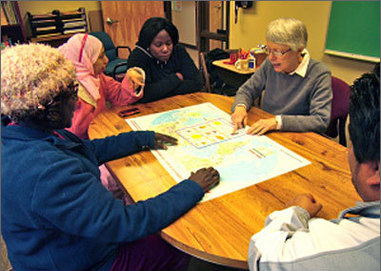 People receiving instruction at Learning in Style.
Jorge already has a bachelor’s degree in psychology and a
master’s degree in social science teaching, but both degrees are from Mexico.
As a result, his teaching license is not valid in Minnesota. Recently, however,
Jorge showed his transcripts to admissions counselors at the University of
Minnesota. They’ve determined that if Jorge finishes his classes at Learning in
Style and takes two years of coursework at the University of Minnesota, he can
earn a Minnesota teaching license.
In addition to teaching, Jorge is interested in becoming a family
therapist or a community health worker and working with people in recovery. He
reveals that the part of his job at Pillsbury United Communities that he found
most rewarding was discovering the needs of people who came in to use the food
shelf and referring them to community resources that could improve their lives.
Burns isn’t surprised by Jorge’s career aspirations. Jorge’s
mother was a health care provider in Mexico, she explains, and he grew up with
her example of helping struggling people. Jorge, says Burns, “has a lovely
model” for how to live a life. “You don’t forget the people who guided and
supported you and you use these experiences to help others.” Recently, Burns
overhead Jorge talking to another patient at Medicine Clinic about food shelf
opportunities in the Twin Cities.
As counterintuitive as it sounds, Jorge believes that there is
an upside to struggling with medical, behavioral health, and social problems; according
to him, they’re “opportunities to make a change.”
Jorge has a message to Hennepin Health: “I want to thank all
of you. I feel fortunate and blessed. You changed my life.”
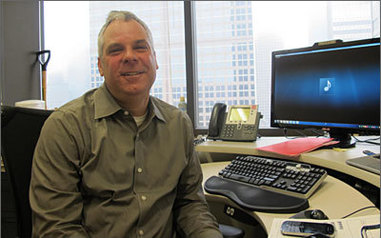 Markus Klimenko is the program manager for Hennepin County’s
Housing
and Homeless Initiative. Nestled within Hennepin County’s Human Services
and Public Health Department, HHI has a lofty goal: ensure that all Hennepin
Health members have access to housing.
Klimenko explains that his job involves building
partnerships with Hennepin County housing providers and working with these
providers to supply housing for homeless residents. There are currently 8,500
housing and housing service opportunities available through HHI.
In addition to increasing the supply of housing in the county,
HHI is also building a “specialized housing tool.” The e-government initiative,
Klimenko explains, will allow housing navigators to view housing vacancies in
real-time.
A long-time member of Hennepin Health’s care model
committee, Klimenko has advised Hennepin Health’s partners on housing policy
and housing opportunities within the county.
Klimenko also helped build Hennepin Health’s housing navigation
team. From January 2012 to December 2013, the team placed 150 Hennepin Health
members in housing. Hennepin Health is currently analyzing these members’ medical
claims to determine how placement in housing affected their emergency
department, inpatient hospitalization, and outpatient utilization. Hennepin
Health is also in the process of hiring additional housing navigation staff.
Klimenko believes that housing a person can be
transformative. “Housing policy is health policy,” he says.
Hennepin
Health held its first new member event on March 26 at the Grain Exchange
Building in downtown Minneapolis. Hennepin Health invited people who had joined
the program between January 1 and March 1, 2014. Approximately 40 members
attended.
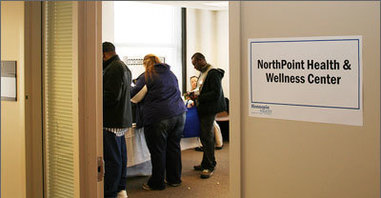 The goals of
the event were to orient members to Hennepin Health resources, educate them on
how to establish care, and introduce them to some of Hennepin Health’s
providers.
Staff from
across the Hennepin Health partnership volunteered at the event. Special thanks
to:
 Were you
there? Do you have suggestions on how to improve future events? If so, email
Lori Imsdahl, Hennepin Health operations coordinator at lori.imsdahl@hennepin.us
Help us reach 100 "likes" by sharing our page with others. https://www.facebook.com/hennepinhealthcare
|